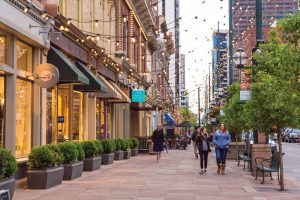— By John Gajewski, MRICS —
Retail strategies for leveraging historic assets to build a competitive edge.
In a highly competitive, complex and dynamically shifting retail market, all eyes are on innovative solutions, and the conditions created by the COVID-19 pandemic have provided a catalyst for transformation. Takeout eateries and online megastores dominate the retail market based on convenience, selection and pricing. Traditional retailers must compete on alternative measures. Urban Outfitters, RH (formerly known as Restoration Hardware) and

John Gajewski, Partner Engineering and Science Inc.
The Old Spaghetti Factory, some of the brick-and-mortar retailers that have also faced growing disruption from e-commerce and pandemic fall-out, are turning to historic properties to compete for clientele. Rehabilitation of historic properties with their distinctive architecture and inimitable character, offer inherent differentiators, and with proper project risk mitigation can be a profitable venture that benefits the project owner, retail tenants, consumers and their communities. Here are some highlighted strategies demonstrating how retailers are leveraging historic buildings to build a competitive edge.
Enriched Shopping Experience
When consumers opt for brick-and-mortar shopping, they are often seeking an experience: vibrant, sociable settings; dining and entertainment options; or special offerings from small or local businesses. Historic properties bring unique characteristics, quality atmosphere and sensory stimulation to satisfy experience-hungry customers.
 Shoppers prefer retail and hospitality experiences in proximity to non-retail, mixed-use amenities, such as co-working franchises, apartment living, civic amenities and leisure facilities — many of the components naturally provided by downtown shopping districts. New retail developments are often patterned after “Main Streets,” with courtyards and fountains, and rhythmic façades that mimic smaller individual buildings. Metro urban growth across the United States means that developers and investors have the opportunity to tap underutilized historic downtown real estate to create these desirable districts, essentially by reusing the main streets that many cities and towns already have. Historic non-retail warehouses and industrial facilities can convert very well into retail and restaurants, due to their inherently flexible open-plan spaces and gritty aesthetic. Conversely, abandoned retail and department stores in downtown locations can be ideal for reuse as offices, galleries, loft apartments and more, with large storefront windows and open interiors.
Shoppers prefer retail and hospitality experiences in proximity to non-retail, mixed-use amenities, such as co-working franchises, apartment living, civic amenities and leisure facilities — many of the components naturally provided by downtown shopping districts. New retail developments are often patterned after “Main Streets,” with courtyards and fountains, and rhythmic façades that mimic smaller individual buildings. Metro urban growth across the United States means that developers and investors have the opportunity to tap underutilized historic downtown real estate to create these desirable districts, essentially by reusing the main streets that many cities and towns already have. Historic non-retail warehouses and industrial facilities can convert very well into retail and restaurants, due to their inherently flexible open-plan spaces and gritty aesthetic. Conversely, abandoned retail and department stores in downtown locations can be ideal for reuse as offices, galleries, loft apartments and more, with large storefront windows and open interiors.
Bridging Building Stock Gap
As investors seek to place capital in a highly competitive real estate market, developers, investors and occupiers — including retailers — have tapped into enormous value from underutilized or obsolete building stock. Looking for a unique “destination concept,” with impressive high-ceiling space for gathering, good natural lighting from large windows, and a rich blend of old and new to support retail branding and identity? Why not look at reusing former gas stations, theaters, banks or train terminals? A recent Deloitte study found 50% of respondents acquiring property solely for repurposing, but 60% said they were held back by economic, legal and physical constraints. A consultant with expertise in adaptive reuse — and particularly with historic properties — can help overcome these constraints and unlock the growth potential of historic assets.
Maximizing Financial Incentives and Tax Credits
Designated historic properties are eligible for Federal and State Historic Tax Credits, a unique benefit only available to designated historic buildings either individually listed or in a historic district. These tax credits combined can provide up to 45% toward the cost of qualifying rehabilitation works. In a construction market where supply chain issues and labor constraints have driven prices sky-high, this is a significant benefit. If a historic property is not designated on the National Register of Historic Places, it is often worth seeking designation to create eligibility for such tax credits. A historic preservation consultant can evaluate and submit the property or district to be accepted onto the National Register, then guide the developer through the Historic Tax Credit process.
Historic Tax Credits can also be bundled with other financial incentives such as New Market Tax Credits, Opportunity Zones, Tax Increment Financing, Enterprise Zones, local grants and façade improvement schemes, and other programs.
Understanding a Historic Asset
A successful, sustainable, historic reuse project requires a professional engineering assessment of the property to determine what is required for the building to be viable, feasible and fit for its proposed use, with special consideration for historic building concerns such as condition, structural integrity and reuse of MEP systems. A qualified consultant should assess energy usage, carbon footprint and emissions, embodied energy and financial paybacks, along with an assessment of historic significance to sustain and enhance the qualities of the architecture. Working with historic adaptive reuse projects requires a good understanding of costs and processes, much of which can be reduced through enhanced due diligence and capital planning by a consultant who understands the many facets involved, including historic repair techniques, costs, permitting and tax credits.
Sustainability, Social Impact and Brand Identity Enhancement
The reuse of historic properties to create sustainable retail spaces may appeal to environmentally- and socially- conscious investors, tenants and consumers while strengthening brand identity and loyalty.
Reuse is a tenet of environmental stewardship. Demolishing and rebuilding consume far more raw materials and energy than rehabilitating and reusing an existing building. Beyond initial development, retail interiors and storefronts must undergo more frequent renovations than most other building types to remain competitive. These frequent renovations create unnecessary waste. Reusing existing historic elements (or using salvaged materials) and integrating them with modern retail and restaurant design on a less frequent cycle is more sustainable, saves money long term, creates unique spaces and is more historically sensitive.
Reuse of historic buildings can have a significant social impact, too, especially as part of revitalization efforts. It can provide a catalyst for economic recovery in areas impacted by the recession. Keeping buildings occupied and in use protects them from deterioration. Sensitive rehabilitation of interiors and storefronts can increase business and provide evidence of a successful district revitalization.
Historic commercial properties are also excellent incubators for “entrepreneurial ecosystems.” They provide variety, including small and diverse spaces with a range of rents including affordable. They also provide critical transition spaces for small businesses growing from pop-ups and market stalls to brick-and-mortar retail establishments.
Finally, regeneration of the historic built environment supports the community, tapping into cultural identity and preserving local heritage and the community’s sense of place.
— John Gajewski, MRICS, is the technical director of historic architecture solutions at Partner Engineering and Science, Inc. He advises commercial and corporate clients on risk management and value optimization of their historic buildings, property transactions and portfolios. His expertise spans renovation, rehabilitation, enhancement and repair of buildings of architectural and historic significance, including technical due diligence and construction projects. For more information, visit www.partneresi.com.

